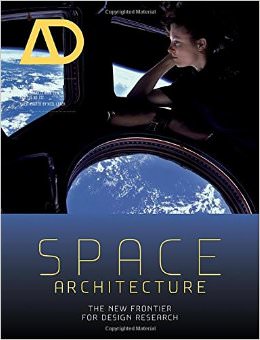Have you ever had one of those days when you just couldn’t complete another Fourier Transform no matter how many chocolate covered cacao nibs you consumed? You need to perk yourself up, maybe imagine something a little more exotic than a Volkswagen diesel scooting down a gravel road. Well then, pull up a chair and grab a copy of the last Architectural Design issue of 2014 entitled “Space Architecture – The New Frontier for Design Research”. Sure it’s got some pretty involved speculative prose, but the graphics are stupendous and will knock you right back into a can-do mindset.
This compilation by Architectural Design is its third strictly related to space architecture; the other two being in 1967 and 2000. In this one, Neil Leach is both editor and an occasional writer. The book’s contents give the impression that Leach had free reign in choosing authors and content with its broad range and scope. As with most general publications on current space activity, it includes some fairly well known content. For instance, it’s got articles from both Robert Zubrin on colonizing Mars and Buzz Aldrin on a mission to Mars. While the articles add little to what the authors regularly say in public, some of the attached images look relatively fresh.
As well, in keeping with the book’s title on architecture, some articles have a bit more of an industrial viewpoint. An instructive article details the design methodology used for the International Space Station while another plants some forward thinking utility of 3D printing for lunar load bearing walls. These may perk the interest of practicing architects but for real fun you need take a look at the more whimsical selections. In one, architecture combines research of the human vertebrae together with Italian city-scapes to establish spatial qualities and shapes for extraterrestrial platforms.
In another, a pulled-together assembly of orbiting space junk seeded with a soft interior fabric of artificial soils resembles a cassis fly shell which is then to metamorphose into a functional space environment. Is this a little too far out for you? Well come back closer to today with a plan for a MoonCapital, a habitation for people on the Moon. Or, there’s a spacecraft with a tethered outrigger that provides artificial gravity for long term voyages. These demonstrate the expanse of the collection of articles brought together in this book. Yet, it’s the detail, especially of the imagery, that gives spice to the reader’s imagination. True, most of the images are architect’s computer generated graphics but sometimes you feel, or at least hope, that you can simply reach out and touch them.
While this book is a great collection of things space related, it does suffer from this. That is, it is just a collection. Also, as with anything speculative, it doesn’t really have a purpose. Its goal is to “cast its eye on the [time] horizon for what may be happening next culturally, socially and technologically”. This broad scope makes relevant almost anything space related. Fortunately the editor, David Leach, doesn’t let this mandate get too vague as the topics are usually pertinent and somewhat current. In the end, a reader may be left with a feeling that too much was attempted which thus left too many gaps. Or, they may get the inspiration to fill in some of the spaces. Certainly no one would suffer if the later was the result.
Perhaps inspiration is the intent of the speculative architecture in this wonderfully illustrated book “Space Architecture – The New Frontier for Design Research”. With a fine collection of topical pieces, the editor David Leach lets architectural considerations come to bear upon humanity’s current and hoped for activities in space. The reader can appreciate the skills of these professionals and get a glimpse of what may just be over the horizon for our civilization.
This book is available on Amazon.

